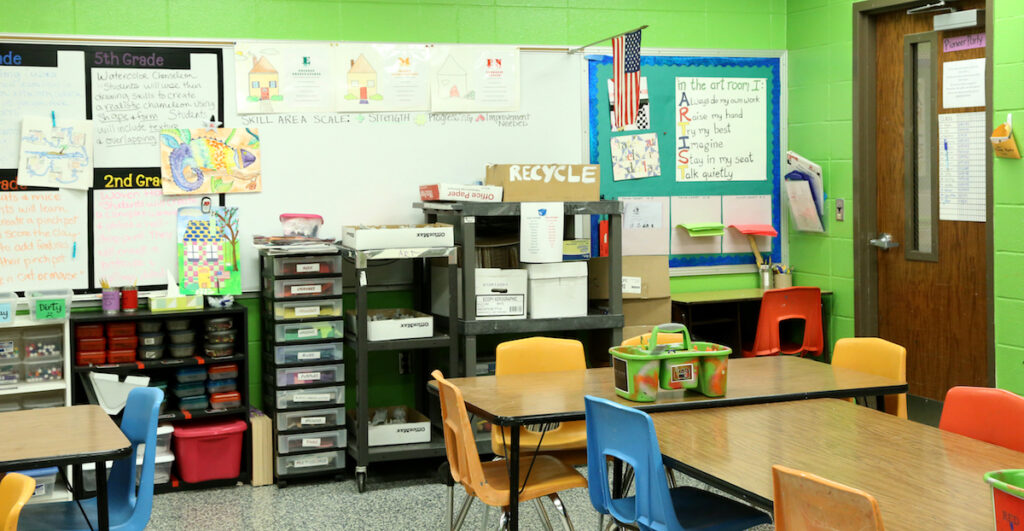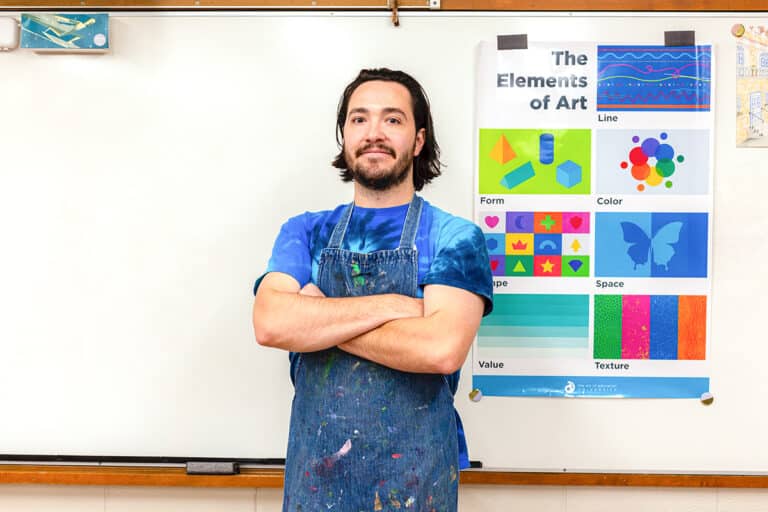It’s that time of year when jobs start to open up and art teachers everywhere are applying for new positions. While the wait to get an interview is bad enough, the anxiety can really kick in once you have one scheduled.
Combat those butterflies by brushing up on your interview skills. Having just gone through the interview process myself, I’ve put together a list of 10 common interview questions and how to answer them. Read on to prepare for your next gig!
10 Common Art Teacher Interview Questions

1. Tell us about yourself.
This question is not an invitation to launch into a 15-minute long story of your life. Briefly, discuss your education, past experience, and any other noteworthy professional tidbits. Round it out with a few sentences about your life outside of the classroom.
2. Why do you want this position?
Make sure you stick to the positives here. Even if you are desperately trying to find a first-time job or you are looking to get out of a bad climate at another school, don’t go there. Instead you might start with something like, “I want this position because I want to challenge myself as an educator and grow as a professional. I love what I do, and I always want to make sure I am stretching myself.”
3. Are you comfortable using technology? If so, how do you use it in the art room?
If your answer isn’t “yes,” consider brushing up with some technology courses before you interview. Share how you have used your iPad, Smart Device, document camera, or another form of technology in the classroom.
If you’re looking for specific ways to brush up on your tech use, consider taking AOE’s course iPads in the Art Room. You’ll become proficient in a variety of digital applications to enhance the creative process for students. There is also a helpful Flipping Your Classroom Basics PRO Learning Pack that shares instructional strategies to help you seamlessly integrate flipped videos into your classroom and curriculum.

4. What is your classroom management style?
Discuss how you keep students engaged with relevant, fun projects to minimize management issues, then discuss your specific classroom management plan. If you don’t have a plan, consider taking the Managing the Art Room course to help you create one.
5. How do you accommodate students with special needs in the art room?
Share some general thoughts about working with students with special needs in the art room. Then, highlight one or two specific accommodations you’ve made for students in the past.

6. If I were to ask others at your school what you have done to improve the art program, what would they say?
It might feel weird to toot your own horn, but this is the time to do it. Try to highlight where the program started when you arrived and where it is now. For instance, I shared how I started a fundraiser my very first year to help stretch the art budget and spotlight the art program. If you don’t have a classroom yet, talk about some of the goals you have for the program.
7. How do you work and collaborate with others?
Now is the time to mention how you have collaborated with other art teachers in a PLN, formed tight bonds with co-workers, or have juggled traveling to multiple schools. Your interviewer wants to make sure you will be a breath of fresh air instead of a burden. Highlight any big collaborative projects you’ve done like bringing in an artist-in-residence or organizing a large-scale legacy project.
8.How do you communicate with parents?
These days, there are so many different ways to communicate with students’ families. Highlight the ways that have worked for you. Don’t forget to mention reasons you contact parents for positive reasons like outstanding student behavior, successes for struggling students, and to communicate the happenings of the art room. You want to give the impression that you feel comfortable and confident contacting parents. If you’re afraid to talk to parents, now is the time to practice!

9. Why do you want to work in this school?
Of course, it is always a good idea to do some research on the school or district to which you are applying so you can mention specifics, but there’s something to be said about letting your passion come out too. Don’t just let this be about getting a job. Being in a school is sort of like being in a family. Passionately state why this “school family” is the right fit for you.
10. We’ve had several other candidates interview for this position, why should we pick you?
Be genuine and to the point on this question, because it’ll probably be the last question you hear. What makes you the best? What can you bring to the table that no other candidate can? If there was ever a time to make yourself shine, this would be the question to do it on.
Chances are, once you’ve finished answering your questions, the tables will be turned. Don’t forget to come prepared with your own questions to ask! Here are some of my favorites:
- What does the daily schedule look like? Are there additional daily duties beyond teaching classes?
- Are there opportunities to become involved in extracurricular activities?
- Is there any travel involved with this position?
- Are there any committees that I could become involved with?
- How big are class sizes at this school?
- What is the art budget like?
- What technology resources will be available to use?
- Could I take a peek at the art room?
The best advice I have for nailing your interview is to practice, not memorize, your answers to these questions. Have an idea in your head of what you will talk about if asked one of these questions, but keep things loose to avoid sounding like a robot. Instead, just act like you are having a regular conversation about the topic and give a response.
Don’t forget to smile and laugh too. Remember, they want someone who the kids will feel comfortable around just as much as they want someone who knows their stuff.
Good luck on your next interview!
Did we miss a common interview question? Share your insider knowledge in the comments!
What’s your best advice for nailing an interview?
Magazine articles and podcasts are opinions of professional education contributors and do not necessarily represent the position of the Art of Education University (AOEU) or its academic offerings. Contributors use terms in the way they are most often talked about in the scope of their educational experiences.





